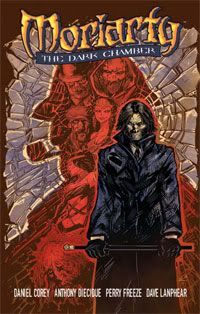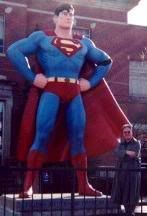| Pop Culture Gadabout | ||
|
Monday, October 10, 2011 ( 10/10/2011 02:31:00 PM ) Bill S.  “THE WORLD NEEDS A VILLAIN AT PRESENT.” The idea of centring a series on Sherlock Holmes’ arch-enemy, Professor James Moriarty, is nothing new. British writer John Gardner (who also successfully commandeered the James Bond franchise for many years) wrote a trio of Moriarty novels in the 1970’s, though his approach was not as fantastickal as the crew who put together Moriarty: The Dark Chamber (Image Comics). Scripted by Daniel Corey with a dash of sci-fi plotting and more than a trace of League of Extraordinary Gentlemen pastiche-ry, the four-ish mini-series provides an entertaining riff on Sherlockian lore. If Corey lacks League creator Alan Moore’s penchant for complex literary play, he does construct an enjoyably slam-bang divertissement. “THE WORLD NEEDS A VILLAIN AT PRESENT.” The idea of centring a series on Sherlock Holmes’ arch-enemy, Professor James Moriarty, is nothing new. British writer John Gardner (who also successfully commandeered the James Bond franchise for many years) wrote a trio of Moriarty novels in the 1970’s, though his approach was not as fantastickal as the crew who put together Moriarty: The Dark Chamber (Image Comics). Scripted by Daniel Corey with a dash of sci-fi plotting and more than a trace of League of Extraordinary Gentlemen pastiche-ry, the four-ish mini-series provides an entertaining riff on Sherlockian lore. If Corey lacks League creator Alan Moore’s penchant for complex literary play, he does construct an enjoyably slam-bang divertissement.Set at the start of the Great War, twenty years after Moriarty “bested” his detective adversary at Reichenbach Falls, the series follows our anti-hero as he is pressed by British intelligence into uncovering the whereabouts of Holmes’ brother Mycroft. Hiding under the name Trumbold, Moriarty has seemingly lost much of his reason for living after vanquishing Holmes: now he ekes out a living as “a sort of investigator for the criminal element” and an import/exporter. His enquiries pit him up against a cultish group named the Sons of Chaos and a mysterious box that Moriarty calls “A Dark Chamber of the Mind.” What this device can actually do is never concretely explained, but we know it will be monstrous. Author Corey brings in other figures from the Holmes canon, of course, but the most engaging secondary figures to be a Sax Rohmer-esque queenpin named the Jade Serpent. Teaming with, betraying, then re-teaming with the Professor, she’s just the kind of lithe-limbed action-ready anti-heroine that this story needs. Artist Anthony Diecidue’s ink work captures the milieu, though at times comes across a mite too sketchy to convey the full weight of the action. There are times (a confrontation between Jade and Mata Hari, for instance) where his figures look more like manikins, while in other sequences his lines look like they’re about to fly apart. Throughout Dark Chamber, you can see him striving for League artist Kevin O’Neill’s blend of caricature and more straight-laced comic art without quite getting there. Still, I like his basic visualization of the series’ anti-Holmes (who’s given more than one opportunity to display his own style of deductive reasoning), even if he looks nothing like Conan Doyle described him in the stories. This, we’re told is the real Moriarty, not the figure pictured in those published Strand stories. When Watson shows, though, he’s much as we’d expect him to look even if Jade flatteringly states that he’s “not nearly as rotund as the illustrations in The Strand would lead one to believe.” Some genre figures, happily, remain visually unassailable. (First published on Blogcritics.) Labels: modern comics # | |
|
|

